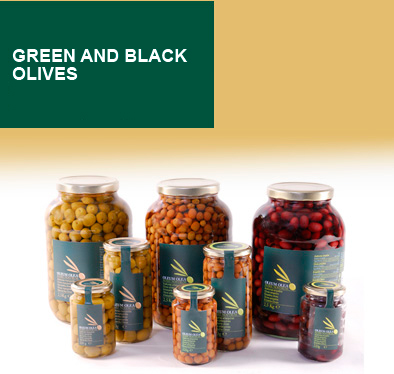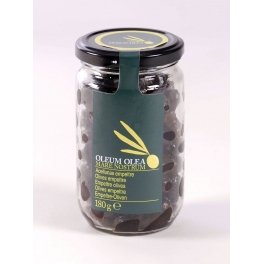|
It is known that olives are nutritious appetizers; they strengthen the stomach and help to clean the intestines.
They can be eaten seasoned, plain, and are also excellent for enhancing dishes.
They are a delicacy of the Mediterranean diet.
VARIETIES OF OLIVES:
Arbequina (green)
Manzanilla (green)
Empeltre (black)
CONTAINER:
Glass jar with screw-top lid: 160 g, 180 g, 220 g, 400 g, 450 g, and 2.5 kg net drained weight.
|

|
OLEUM OLEA MARE NOSTRUM® Arbequina and Empeltre table olives.
Table olives
The Arbequina(green) and Empeltre(black) varieties of olives of OLEUM OLEA MARE NOSTRUM®, could not be consumed directly from the tree given that they are drupes. That is, hard fruits, bitter – due to the presence of oleuropein, aphenolic compound majority in the pulp–and with high oil content – from 12 to 30%. It is, therefore, indispensable to subject them to processes of removal of the bitterness and of fermentation and curing to turn them into an edible product that is first rate; the Catalan table olive.
It is known that olives are nutritious appetizers; they strengthen the stomach and help to clean the intestines. They can be eaten seasoned, plain, and are also excellent for enhancing dishes. They are a delicacy of the Mediterranean diet.
Physical Characteristics
Arbequina (green)
- Shape: High sphericity, symmetrical- Weight: 0.80 to 1.20 g.
- Oil yield: 17.2 to 19.5%
- Flesh content: 67 to 76%
- Color at harvest: shiny green
Lower Aragon (Empeltre)(black)
- Shape: ovoid, asymmetrical- Weight: approx. 2.50 g.
- Oil yield: 19.7 to 27.5%
- Flesh content: 82.1 to 85.3%
- Color: black with a reddish tint
Nutritional characteristics and health benefits
The abundant benefits that olives provide to our health are derived from their unique composition:
Fats: 20% of the total. In 80%, in the form of oleic acid, a monounsaturated fatty acid with proven benefits for the prevention of cardiovascular disease and for increasing levels of HDL cholesterol, the “good” cholesterol.
Proteins: although they represent only 1% of the nutritional content, significant amounts of all of the essential amino acids are found in them.
Carbohydrates: practically free.
Fiber: approximately 2%, a very high proportion. This is a component of great importance for digestive function and for the prevention of colon cancer.
Vitamins: olives are rich in tocopherols and tocotrienols, compounds that perform a crucial function in the antioxidant protection of the organism.Vitamin E is the most abundant, as a-tocopherol, with 50mg/kg. The provitamin A content is also substantial, around 8-10 mg/kg. Vitamins K and D are also present in a significant way.
Minerals: there are significant amounts of sodium, indispensable to the organism,at the rate of about 2 g/day. The calcium content is similar to that found in milk and the magnesium content is three times higher. The magnesium content is important because of its effect on the process of calcification of the bones, to prevent the formation of kidney stones, and boost the action of the glands, enzymes, and the synthesis of white blood cells. Additionally, it provides considerable amounts of iron and copper.
Polyphenols: they can reach up to 6% of the dry matter, a proportion even greater than that found in olive oils. They prevent the development of cardiovascular disease, arteriosclerosis, they have anti-inflammatory and antithrombotic properties and assist in the control of blood pressure. The concentration of polyphenols in olives can reach up to 1,200 mg/kg.
 Maximize
Maximize





FOLLOW US
WE KNOW EACH OTHER
My accountContact us